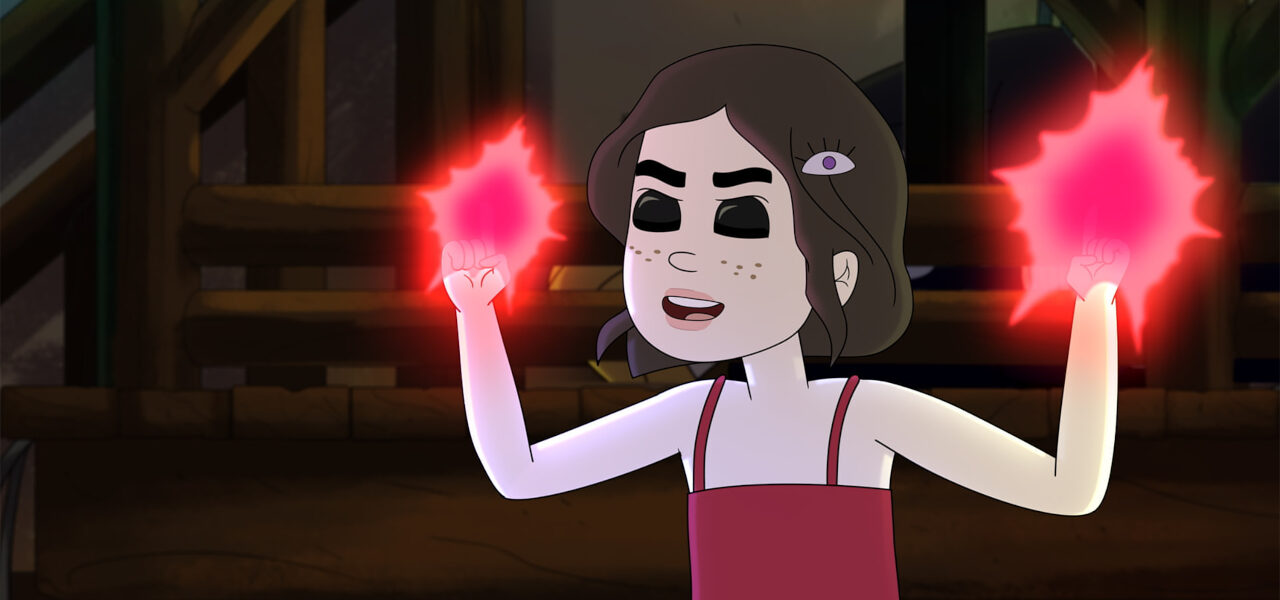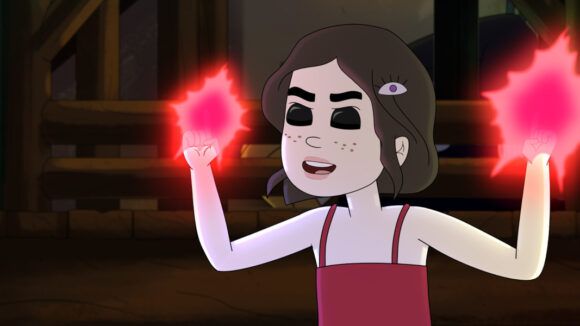

Animating Horror: Series Creators Discuss The Aesthetic Ground Rules Of FX’s ‘Little Demon’
FX’s newest adult animated series Little Demon premieres on FXX at 10 p.m. ET/PT tonight before landing on Hulu tomorrow.
The show unspools in rural Delaware where reluctant mother Laura and her daughter Chrissy do their best to live an ordinary life. The problem is that Chrissy’s absentee father is the actual Devil, who learns about his daughter’s existence and shows up looking to foster a relationship with the girl, although his motives are, predictably, questionable.
Little Demon was created and written by veteran acting-writing-producing trio Darcy Fowler, Seth Kirschner, and Kieran Valla. The series is produced by FX Productions and Shadowmachine, with the later sharing animation duties with Atomic Cartoons and Red Door Animation. Executive producers include Fowler, Kirschner, and Valla; Dan Harmon; series voice actors Aubrey Plaza, Danny DeVito, and Lucy DeVito; and Shadowmachine’s Monica Mitchell, Corey Campodonico, and Alex Bulkley.
Cartoon Brew caught up with the show’s creative trio ahead of its FXX premiere to ask about the challenges of learning animation as creators from the live-action world, the graphic choices they made on the series, and how they managed to strike a balance between comedy, horror, and drama.

Cartoon Brew: Can you talk us through the group showrunning process? And, as this is the first time any of you have led an animated series, could you talk about the challenges you encountered?
Darcy Fowler: We’ve been working together for a while on a bunch of different live-action pilots, so we have had lots of experience leading a production, and I think that experience helped a lot here. Also, working in a room with [Dan] Harmon we learned to break stories. One thing that really excited us about working in animation is that with live action, once you shoot you do everything you can in post, but if you missed something while filming it’s gone. In animation, you’re sort of doing post as you’re storyboarding.
Kieran Valla: One of the things that helped us the most was building an incredible team around us who had lots of experience working in the medium. Animation has so many steps and takes longer than live action to come to fruition, but you can’t really understand those processes until you’ve experienced them. So having people who had the foresight to know what to expect was really helpful. Coming from live action, we didn’t understand the limitations of animation, you know time, budget, and you have to make sure that you’re being resourceful when making decisions. So I think that’s the biggest takeaway from this first season.
Seth Kirschner: And one other challenge we faced was making this show during Covid. Every single thing we did was remote. It would have been ideal to be in an office with each other and be able to go into the next room and give notes, rather than doing every single design review online. Of course, there are advantages to working remotely too, but it was an additional struggle.
How did you handle the differences in writing for animation, and how involved were you in storyboarding?
Kirschner: That’s something we are still consistently learning as we go through the process. In live action, the cinematographer has their idea and everyone kind of works from that. Whereas with storyboard artists everyone has their own idea they bring into the meetings and can collaborate a bit more. There is more communication, and it’s a different style of communication. Also, because our show handles horror, comedy, and drama, there are other considerations that need to be made when boarding. Layouts are different depending on what kind of scene we’re shooting.
Fowler: That was one of the really cool parts. Bringing these different sequences to the artists and seeing how they would interpret those cinematic moments. And a lot of the time they would come back with something way beyond what we could even imagine when giving notes, or a different angle that we’d never thought of.
Can you discuss the aesthetic choices you made for this show? It’s more realistic looking than a lot of the other adult animated series aimed at a similar audience.
Valla: Very early on we started working with our design team to develop the look of the series. A lot of the shows that operate in the same space as ours, adult animation comedies, can be a bit more cartoonish, exaggerated proportions. For our visual references, we used a lot of live-action work to bring a look and feel that was more horror-based and realistic. We wanted to push the show into these real horror scenes, which we didn’t feel had been done in adult animation that often. In order for the horror to land, we needed our character acting to be a bit more nuanced. That’s why we wanted characters that were a bit more proportional in the way they looked, and why we gave them actual pupils and sometimes color, so we could access their eyes more, especially in the horror moments.
For Laura, we wanted a kind of Sarah Connor vibe. Someone who looks like they can handle business but who you also believe could have been kind of a party girl at some point in her past. For Chrissy, we kept things really plain because in the story Laura is trying to keep her hidden for 13 years, so she would have avoided anything that could make her stand out. And then we made her a bit smaller than the other kids her age as a great contrast to the extreme power she can unleash. And for the Devil, that Mr. Rogers, Danny Tanner look was originally a joke for the pilot but then we thought, “What would a father who has been absent for his daughter’s first 13 years want for her?” And the answer was consistency, so that’s why we stuck with that look for him.

A lot of the shows aimed at a similar audience to that of Little Demon are broad comedies or sitcoms, but yours feels more grounded than that. How did you play with genre when developing and producing this series?
Fowler: We constantly reminded ourselves that at the core of this show, we needed to keep it grounded and we couldn’t let the horror or the drama scenes turn into punchlines. We explore lots of themes that lend themselves well to horror: a broken family, a custody battle, a mother/daughter relationship where the kid is 13 and going through puberty. There are all these relatable forms of horror, so as the season went on we got to dive deeper into these significant, but darker stories centering on those themes.
Valla: We believe we have really compelling characters who are all messy in their own ways and in their relationships to one another. The relationships are complicated and even internal conflict about identity is messy, and I think that’s what really gives the show legs and can keep it going. Satan, for instance, has this whole plan where he’s going to have a son who will help him carry out his plans, then he gets thrown a curveball by having a daughter and it makes him question his own identity in a way he never has before, even though he’s the ultimate narcissist.
Were there any scenes that were particularly difficult to animate?
Kirschner: For me it’s pretty obviously the bathroom scene in the pilot. It took a long time to organize script-wise, just making sure it was clear what was driving the scene. It’s also a really important moment in Chrissy’s life where we had to make sure we’re understanding her and what she’s going through. We wanted to make sure we were hitting the comedy and the horror aspects, but that we also highlighted her inner struggle. Cinematically there’s a lot going on as well, both horror and comedy. The nice thing about working in those genres together though, is that they’re like two sides of the same coin. They’re both about a release of tension.
That scene is important too because it establishes the rules of your universe. That’s the first time that we see the people of the Little Demon world just being cool with crazy supernatural stuff happening.
Fowler: That was incredibly important. We were playing a bit with that old, “every generation says that the world is ending” trope, but everyone keeps on going. In the world of Little Demon, when we have a black hole open in the sky we wanted the people to be more annoyed about their rose gardens getting sucked up or be worried about how it will affect the economy of the town or cause a roadblock. It sets up the entire rest of the season.

.png)